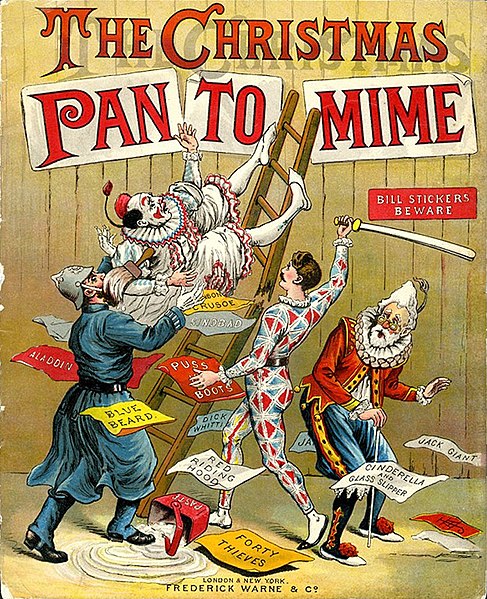Harlequinade is an English comic theatrical genre, defined by the Oxford English Dictionary as "that part of a pantomime in which the harlequin and clown play the principal parts". It developed in England between the 17th and mid-19th centuries. It was originally a slapstick adaptation or variant of the commedia dell'arte, which originated in Italy and reached its apogee there in the 16th and 17th centuries. The story of the Harlequinade revolves around a comic incident in the lives of its five main characters: Harlequin, who loves Columbine; Columbine's greedy and foolish father Pantaloon, who tries to separate the lovers in league with the mischievous Clown; and the servant, Pierrot, usually involving chaotic chase scenes with a bumbling policeman.
An 1890 bookcover showing the harlequinade characters
John Rich as Harlequin with batte, c. 1720
Illustration of the Harlequinade in The Forty Thieves (1878), showing Swell, Pantaloon, Harlequin, Columbine (above), Clown and Policeman
The Payne Brothers as Clown and Harlequin, c. 1875
Pantomime is a type of musical comedy stage production designed for family entertainment. It was developed in England and is performed throughout the United Kingdom, Ireland and in other English-speaking countries, especially during the Christmas and New Year season. Modern pantomime includes songs, gags, slapstick comedy and dancing. It generally combines gender-crossing actors and topical humour with a story more or less based on a well-known fairy tale, fable or folk tale. Pantomime is a participatory form of theatre, in which the audience is encouraged and expected to sing along with certain parts of the music and shout out phrases to the performers.
The Christmas Pantomime colour lithograph book cover, 1890, showing harlequinade characters
2nd-century Macedonian theatrical sculpture, thought to represent a pantomime's mask
John Rich as Harlequin, c. 1720
Playbill of an English circus and pantomime performance, 1803






